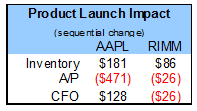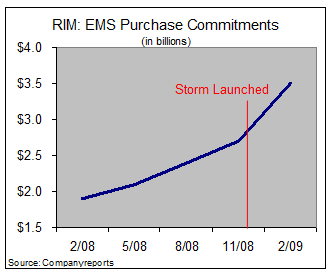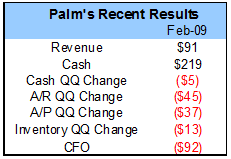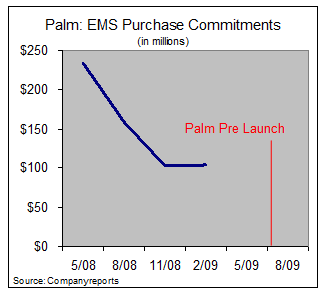P-Day May Hold Surprises
Palm fans are looking to the Pre smartphone as the company's savior, but can it build enough of them?
May 29, 2009

June 6 is not only the 65th anniversary of D-Day; it is also going to be P-Day, the day the Palm Inc. Pre makes its debut at wireless service provider Sprint Corp. (NYSE: S). Fans have been waiting for this moment with bated breath since its limited introduction at the Consumer Electronics Show in January.
Will we have devotees camping out at Sprint locations in advance? Who knows, but I think there are a couple of things that you can count on and those are stock-outs and shortages. The pundits will coo about the strong demand, but I think the reality is something quite different: the lack of cash. Palm is woefully short on cash, and that may make for a limited build of the Pre as it marches toward launch.
Since Elevation Partners established its position in Palm about six quarters ago, the company has seen its cash position dwindle from $627 million to $219 million as of its February quarter. Part of this is the result of a $9 per share special dividend to assuage shareholders, but the company has also managed to burn about $145 million on operations as well. Over this same period its debt expanded from zero to $395 million. I’m not suggesting that the deal with Elevation Partners was a bad idea from a strategic perspective, only that the development and launch of a new product such as the Pre is a very expensive proposition for any company, let alone one in a precarious financial position.
Realistically, if the IHS iSuppli “guesstimate” of the Pre cost of goods sold (i.e. $170) is even close to being correct, just how many units could be manufactured before they run out of cash? Not even 1 million, and that assumes there was no further deterioration in the company’s financial position in its current (May) quarter. I’ll come back to this in a minute, but let’s look at some of the things that happen from a financial perspective when you launch a new product.
Both Apple Inc. (Nasdaq: AAPL) and BlackBerry had major new product launches last year with the iPhone 3G and the Blackberry Storm, respectively. While neither is the perfect analog, we can get a sense of the impact of these launches from their financial data in the table below. Granted, Apple’s data is certainly less revealing given its Macintosh operations, but it’s still instructive. The data shown are the sequential change for Apple in the June quarter of 2008 and for RIM in the November quarter of 2008.
As you would expect, inventory should go up as the companies ramp production to fill the channel. Since production is not a free service, the contract manufacturers need to be paid, so accounts payable decreases and that draws down cash balances. Lastly, cash from operations usually takes a hit as well because of the investment in the new product without the offsetting sales and collections. For RIM, cash from operations declined sequentially about $26 million. While the corresponding figure at Apple actually increased $128 million, keep in mind that in the same period a year earlier the sequential gain was nearly $500 million. Consequently, I think it’s fair to say that there was a definite impact at Apple as well. Next Page: By the Numbers
Next Page: By the Numbers
What may be the most interesting data points are represented in the following two graphs. In each you can see the off-balance sheet purchase commitments to contract manufacturers made by each company as they ramp in advance of the product launch. Here again, there are obviously other products involved in these commitments, but I think the point is an obvious one – if you’re going to sell big, you need to ramp at your manufacturers in advance.
 Returning to Palm, their situation is probably more analogous to the iPhone from a timing perspective, in that that will launch only days after the end of their quarter. The question becomes, will they have sufficient cash to fund a meaningful rollout? While we don’t have their May quarter data (and won’t until well after June 6), the February data isn’t telling a positive story.
Returning to Palm, their situation is probably more analogous to the iPhone from a timing perspective, in that that will launch only days after the end of their quarter. The question becomes, will they have sufficient cash to fund a meaningful rollout? While we don’t have their May quarter data (and won’t until well after June 6), the February data isn’t telling a positive story.
The company generated only $91 million in revenue and exited the quarter with $219 million in cash, down $5 million from the prior quarter. Accounts receivable declined $45 million, meaning the current quarter has lower outstanding balance to collect as a source of cash. Accounts payable also declined sequentially thereby acting as a drain on the cash position, and inventory is not building but going down. Palm’s operations burned $92 million in the quarter, and given that, the only reason the cash position did not decline at a faster rate was the sale of $100 million in Series C Preferred Stock to Elevation Partners. This tenuous situation was not lost on the street during their last conference call. In response to several questions about the expected cash burn rate going forward, management responded that it would not discuss the cash burn rate, but they felt that they’re in a “excellent” position to launch the Pre. Hey, what else would you expect them to say?
This tenuous situation was not lost on the street during their last conference call. In response to several questions about the expected cash burn rate going forward, management responded that it would not discuss the cash burn rate, but they felt that they’re in a “excellent” position to launch the Pre. Hey, what else would you expect them to say?
Next Page: Pay to Play
Now let’s add in a picture of Palm’s contract manufacturing commitments over the last several quarters like we did with Apple and RIM. Figuring that shipments to Sprint commence about two weeks prior to June 6, less than 90 days ahead of that point the purchase commitments are essentially unchanged from the prior quarter. Since the end of the February quarter Palm has raised about $100 million via stock sales. While that may sound like substantial relief for their withering cash balance, my gut tells me that at best it will only offset the cash burn in the quarter and, more likely, may not even do that.
Since the end of the February quarter Palm has raised about $100 million via stock sales. While that may sound like substantial relief for their withering cash balance, my gut tells me that at best it will only offset the cash burn in the quarter and, more likely, may not even do that.
Palm burned more than $90 million in cash last quarter on an equivalent level of revenue. However, in the May quarter, revenue is expected to decline further with current street consensus at $77 million suggesting that on the revenue decline alone, cash burn may actually increase. Then there’s the issue of operating expenses (opex).
I know a number of sell-side analysts are expecting opex to come down to “low $90 million range” as Palm benefits from restructuring actions put into place a while ago. This figure compares with about $95 million in the February quarter and about $114 million a year ago. However, a careful reading of the conference call transcript reveals the company characterized this as “core opex,” and it doesn’t include accelerated R&D (for the WCDMA product) or Pre launch expenses. Consequently, actual operating expenses in the May quarter will likely be up sequentially.
With about $100 million in opex in the May quarter, if Palm built 500,000 units they would be close to being out of cash based upon that iSupply guesstimate. Complicating this issue is the fact that mobile phone LCD pricing is up about 10 percent to 12 percent in the last few months and that MLC NAND flash pricing is up 30 percent to 50 percent over the same period. Consequently, the bill of materials is moving in the wrong direction for Palm.
Barring a magical turnaround in Palm’s fundamentals or another infusion of cash from Elevation partners, it is not going to surprise me if the initial build is only in the 200,000 to 400,000 unit range. That will insure there will be stock-outs and shortages. Compare that with Apple’s sales of 1 million units over the first weekend of availability (granted with a much bigger distribution channel).
I could certainly be wrong on this, but Palm has undergone a near-death experience of late. The Pre has to be highly successful to translate into a bright future for the company. Unfortunately, it doesn’t have long to achieve that success.
— Bob Faulkner, Special to Unstrung
You May Also Like


_International_Software_Products.jpeg?width=300&auto=webp&quality=80&disable=upscale)







